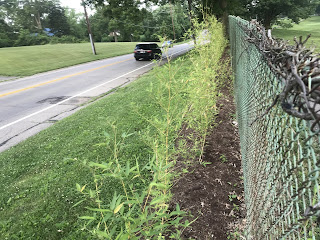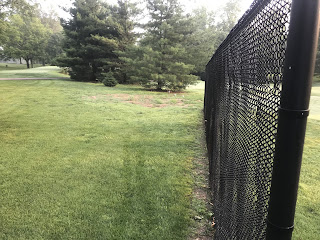 |
| Hydrangea arborescens 'Incrediball' |
It's June and summer has finally arrived! Unfortunately, the abundant spring rains are continuing. I may sound like a broken record, but it has been WET! How wet, you ask? Well, according to the
National Centers for Environmental Information the last 12 months (June 2018-May 2019) in the contiguous U.S. have been the wettest on record. With records going back to 1895. We have also experienced the wettest January to May period in U.S. history. June typically can be another wet month, so we may break another 12 month record, only time will tell.
Mother nature's abundant amount of rainfall has been enjoyed by the newly planted summer annuals. We get all of these annuals from Roger and Linda Feist at
West Hills Greenhouse in Delhi. The Delhi area has the nickname of "Floral Paradise of Ohio," and for good reason. At one time there were approximately 60 operating greenhouses in Delhi, now there are around 6. Here at WHCC we are trying to keep this nickname alive by purchasing our annuals from a local distributor and taking pride in our horticulture program to help keep the West Side the "floral side" of Cincinnati. We incorporate many tropical annuals into our designs such as: new guinea impatiens, cannas, elephant ears, crotons, caladiums, pygmy date palms, and pentas. They are just starting to root in, and with adequate moisture and fertilizer they should double in size in the next month.
 |
| Pink cannas, white caladium, sumo petunias, english ivy, and dragon wing begonias in pots |
 |
| yellow marigolds, gomphrena 'fireworks', and canna australia by pool |
 |
| crotons by 11 tee |
June is a great time for the perennial and shrub flowers as well. The bed behind #11 tee is filling in nicely with the perennial flowers starting to show. The incrediball hydrangeas are coming into bloom and can be viewed anytime while enjoying a meal on the back patio. Our president, Mr Oberklaus, had the idea of putting in bamboo as a screen for the fence holes that run parallel to the street. The right of #12 is our test plot, and after a pretty harsh winter the bamboo is looking healthy.
On the turf side, the rainfall has increased our spray program. We are having to make bi-weekly spray applications to keep ahead of fungal diseases. One such disease that effects poa annua and bentgrass is anthracnose. Basal rot anthracnose, specifically, occurs during cool wet springs with overcast conditions right after peak flowering. We were able to keep the disease off of fairways, tees, and greens with diligent spraying, but the rough fell prey. We had to move up our rough spray application (usually first spray is end of June) to combat this, and we are applying a fungicide combined with a high nitrogen fertilizer to the play rough; however, it is impossible to spray the entire rough without having a budget close to Augusta National.
 |
| Anthracnose in the rough in front of #9 fairway |
The irrigation system has not been used as of late, but significant maintenance has been accomplished in the form of leaks and computer issues. Currently, we have replaced 2 face plates, a modem, repaired 3 bell-end pipe leaks, and 4 foot valves. With over 1000 heads, this comes with the territory but this year has already been a busy year for the irrigation department. Hopefully, the kinks will be out by the time the dry, hot mid-summer weather arrives.
 |
| Bell-end pipe leak right of #2 green |
A new roller has been purchased to help with our greens maintenance program. It is a newer salsco roller that will replace our old one that was purchased in the 1990s. It is bigger with a rolling swath of 73", weighs 1180 lbs, and has a ground pressure of 7 p.s.i. Also, it can go up to 11 mph helping us to roll faster to stay ahead of morning play.
 |
| New roller in action |
Finally the practice tee is starting to show signs of wear and tear. The grounds crew would like to remind everyone of the proper divot pattern on the practice tees. They should be in a linear pattern for 20 shots spaced around 2 to 4 inches apart. We have also included a new sign at the range for a friendly reminder.
 |
| Not a good divot pattern on our practice tee. It will take more time for this to heal, possibly months |
 |
| Three weeks after a good divot pattern on the lower tee. Notice how quickly they fill in! |
Brad Piecuch
Assistant Superintendent/Horticulturist













